The European Union advocates a digital transformation in Europe. Globalised interconnectedness means widening the scope of financial opportunities for small businesses and enterprises. The European Parliament also intends to support digital education, with which the digital divide in and outside the workplace can be mitigated. The digitisation of public services and the transition to a neutral climate are also presented as a priority.
A digital transformation?
The EU’s digital transformation refers to the adoption of new high-impact emerging technologies in businesses and their repercussion in society. Examples of new technologies include digital platforms, the Internet of Things (IoT), wearable technology, and artificial intelligence (AI), which disrupt relevant domains, from agri-food systems to citizens’ daily life activities. The plan is to allocate an estimated 20% of the €672.5 billion raised by the Recovery and Resilience Facility to the development of digital transformation to diminish the economic and social impact of Covid-19.
Commissioner Johannes Hahn, responsible for the EU Budget, states that Europe’s path to social and economic recovery will be achieved by investing in modernisation ‘via green and digital transition’. In addition, the Digital Europe Programme, approved by the European Parliament in April 2021, has become the first financial instrument created exclusively to bring technology closer to businesses and citizens. The goal of the programme is to invest in digital infrastructure to ultimately ensure technological sovereignty.
The potential of digital technologies in Europe
A macroeconomic simulation by the McKinsey Global Institute estimates that by 2030 the cumulative value of the additional gross domestic product (GDP) from new high-impact technologies could amount to €2.2 trillion in the EU. This means that the economic potential of new technologies is greater than anything we have seen so far. According to the European Commission, the impact is positive, as productivity improvements outweigh other costs and externalities. In particular, AI could benefit people with much more personalised healthcare and safer vehicles, speeding up production processes and providing a competitive advantage for European businesses. However, the Commission advocates proactive convergence between the Member States to reap the benefits of this economic and technological growth evenly, in an attempt to avoid a widening of the digital divide between EU countries.
Social impact and inequality risks
A digital divide can easily reappear and dominate an uneven take-up of new and emerging technologies in the EU. Data privacy and control, access, or digital literacy are some of the issues that could aggravate social disparity. As the Commission states ‘technology may contribute to higher inequality between citizens, companies, and regions’, implying the need for cohesive and inclusive action to close the gap between advanced and less-advanced regions. The Commission also explains that delaying or discouraging the pursuit of digitisation can lead to economic stagnation, while the implications of Covid-19 on employment and GDP call for European action. The significance of educating European citizens in regards to digital skills and their interaction with technology in the workplace is growing by the minute, since 94 million workers are expected to need digital training as technology becomes an integrated part of their occupation, as the Commission states.
A glimpse into the future
To design change, plausible, probable, and possible futures should be envisaged. Deloitte believes that the future of digital transformation in the European Union needs to be properly analysed and anticipated to design more robust strategies and lessen the complexities ahead. Deloitte does this by employing the scenario planning method, which serves to map out the best possible strategies and policies to actively shape societal development, rather than simply reacting to it. For that purpose, it is essential to devise future trends by organising the driving forces, including economic, environmental, legal, political, and social, with the highest level of impact and uncertainty. Four are the possible future scenarios developed by Deloitte: EUtopia, EUsed, EUSSR, and EUniformity. These predictions prepare the European Commission for the challenges and opportunities of a successful European public administration.
The well-being of the EU in its multiple societal spheres hinges on the cohesion and cooperation between the EU Member States for an accelerated, uniform, and inclusive digital transformation.


Follow the comments: |
|
